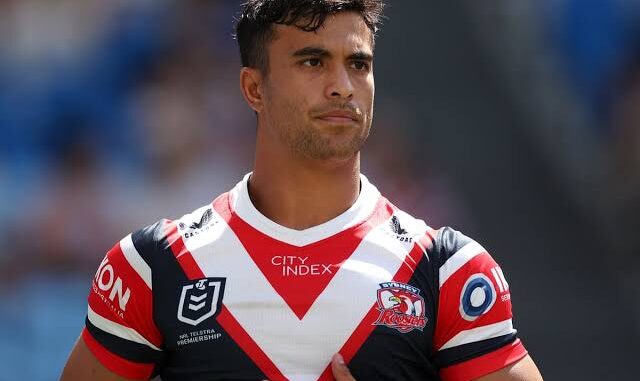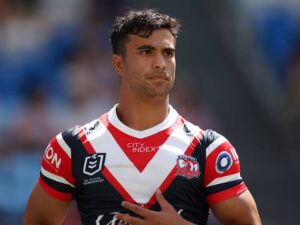
Suaalii’s $9M Rugby Australia Deal Secret Revealed: Controversial Agent Strikes Again
Sydney, October 8, 2024
The rugby world has been abuzz since the announcement of Joseph Suaalii’s sensational $9 million deal with Rugby Australia (RA), marking a pivotal moment in the athlete’s career as he transitions from rugby league to rugby union. However, recent revelations about the details of the contract and the controversial role of his agent, Isaac Moses, have brought new scrutiny to the negotiations, stirring debate about the implications for the future of both the player and the sport.

This comprehensive report will delve into the circumstances surrounding Suaalii’s transfer, explore the financial ramifications of his new contract, analyze the influence of agent Isaac Moses, and assess the broader impact of such high-profile moves on rugby union in Australia.
The Rise of Joseph Suaalii
Joseph Suaalii, born on August 1, 2003, in Sydney, has emerged as one of the most electrifying talents in Australian rugby league. A product of the renowned South Sydney Rabbitohs youth system, Suaalii made his NRL debut at just 17 years old, quickly establishing himself as a key player for the team. His combination of size, speed, and agility made him a standout performer, earning him a reputation as one of the league’s brightest young stars.
After just two seasons in the NRL, Suaalii’s decision to switch codes to rugby union was met with significant media attention. The allure of representing Australia in a sport that has long been considered the country’s second most popular code played a crucial role in his decision. His move was also seen as a major boost for rugby union in Australia, which has been grappling with player retention issues as top talents increasingly gravitate towards rugby league or overseas opportunities.
The $9 Million Deal
The announcement of Suaalii’s $9 million contract with Rugby Australia sent shockwaves throughout the sporting community. The deal, which spans four years, is reportedly one of the most lucrative contracts ever awarded to a player making the switch from rugby league to union in Australia.
Details of the contract revealed that Suaalii’s salary will be supplemented by performance bonuses tied to his on-field achievements and potential selections for the national team, the Wallabies. This structure reflects a growing trend in sports contracts where performance incentives are designed to motivate players while also aligning with the financial realities of the sport.
Suaalii’s move is not only significant for his career but also symbolizes a potential shift in the landscape of Australian rugby. With his star power and marketability, the 21-year-old has the potential to attract new fans to the game and reinvigorate interest in rugby union, particularly among younger audiences.
The Role of Isaac Moses
At the center of the controversy surrounding Suaalii’s deal is his agent, Isaac Moses. A well-known figure in Australian sports management, Moses has built a reputation as a savvy negotiator who is not afraid to push the envelope when it comes to securing lucrative contracts for his clients. While his aggressive tactics have garnered success, they have also drawn criticism and controversy within the industry.
Moses has represented several high-profile players in both rugby league and union, often facilitating high-value transfers that raise eyebrows. His ability to navigate complex negotiations and leverage market demand has made him a sought-after agent. However, some in the industry have raised concerns about the ethics of his approach, questioning whether his tactics prioritize players’ financial gains over their long-term career development.

In the case of Suaalii, critics argue that the young star may be influenced by the financial incentives of his new deal rather than focusing on the necessary adaptation required to thrive in rugby union. Given that Suaalii has primarily played rugby league, transitioning to a new code involves not only mastering different skills but also adapting to a new tactical environment. Critics worry that such high financial expectations could place undue pressure on him to deliver results immediately, rather than allowing him the time to grow into his new role.
The Financial Implications
The revelation of Suaalii’s $9 million deal highlights broader financial dynamics at play in Australian rugby. The sport has faced ongoing challenges, including diminishing crowds, dwindling television ratings, and an inability to compete with the lucrative contracts offered by rugby league. Consequently, Rugby Australia has been compelled to secure marquee players who can drive fan engagement and bring renewed interest to the game.
Suaalii’s contract is a reflection of this urgent need, with Rugby Australia investing heavily in talent that can potentially revive the sport’s fortunes. However, the financial implications extend beyond just the contract value; it raises questions about the sustainability of such deals, especially in a sport that is still grappling with its financial stability.
The Controversy of High-Profile Transfers
Suaalii’s move from rugby league to rugby union is not an isolated incident. In recent years, there has been a noticeable trend of high-profile players switching codes, resulting in significant transfer fees and contracts. This trend has sparked intense debates about the long-term ramifications for both codes and the integrity of player movements.
Critics argue that the influx of money in rugby union could lead to a talent drain from rugby league, which has traditionally been the dominant code in Australia. If young talents perceive rugby union as offering better financial rewards, it could undermine the competitive balance between the two sports.
Moreover, such high-profile transfers can create an uneven playing field within rugby union itself. Clubs with greater financial resources may monopolize top talent, leading to a disparity in competitiveness among teams. As Rugby Australia invests heavily in marquee players, it may inadvertently create a divide between financially sound clubs and those struggling to compete.
The Broader Impact on Rugby Union
The ramifications of Suaalii’s $9 million deal extend far beyond the individual player. As rugby union in Australia faces ongoing challenges, the ability to attract and retain top talent is paramount. Suaalii’s move has the potential to reinvigorate the sport, drawing in new fans and increasing participation at the grassroots level.
However, the risk remains that the emphasis on high-profile signings could detract from the development of homegrown talent. If clubs prioritize marquee players over nurturing local prospects, the long-term sustainability of Australian rugby could be compromised.
Furthermore, Suaalii’s presence in rugby union may change the perception of the sport among young athletes. If other talented players view Suaalii as a role model and aspire to follow in his footsteps, it could lead to an influx of talent into rugby union. This, in turn, could elevate the overall standard of play and contribute to a resurgence of interest in the game.
The Reaction from the Rugby Community
The announcement of Suaalii’s deal has elicited a range of reactions from the rugby community. Supporters of rugby union have embraced the news, viewing Suaalii as a game-changer who can help elevate the profile of the sport. His dynamic playing style and charisma are expected to resonate with fans and bring excitement to matches.

On the other hand, traditionalists within rugby league have expressed disappointment over his departure. Many see Suaalii as a player who could have been instrumental in revitalizing the NRL and fostering a new generation of talent within the league. Critics argue that the relentless pursuit of money has compromised the integrity of the sport, leading to players prioritizing financial gain over loyalty to their original clubs.
Moreover, some former players have weighed in on the implications of such high-profile moves. Rugby legend Michael Cheika, a former Wallabies coach, commented on the changing landscape of Australian rugby, emphasizing the importance of nurturing talent within the sport:
“While it’s great to see young players like Joseph making big moves, we must not forget the importance of grassroots development. The future of rugby in Australia depends on finding a balance between attracting top talent and developing homegrown players.”
Looking Ahead: The Future of Suaalii and Australian Rugby
As Joseph Suaalii embarks on this new chapter in his career, the rugby world will be watching closely. The coming months will be critical in determining how well he adapts to the demands of rugby union and whether he can live up to the expectations set by his lucrative contract.
For Rugby Australia, Suaalii’s presence on the field will be crucial as they aim to reclaim their position among the world’s elite rugby nations. His success could serve as a beacon for other league players contemplating a switch, potentially creating a new pipeline of talent for rugby union.
Additionally, the ongoing discussions about player contracts, agent influences, and the ethical implications of high-profile transfers will continue to shape the conversation within Australian rugby. As the sport evolves, stakeholders must navigate the complexities of player movements while ensuring the integrity and sustainability of the game remain intact.
In conclusion, Joseph Suaalii’s $9 million deal with Rugby Australia marks a significant milestone in his career and the future of Australian rugby. While the excitement…
Leave a Reply